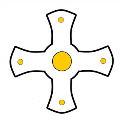Eco Policy
- St Cuthbert’s House is situated in a small village on the edge of the wolds & surrounded by farmland, both arable & pastoral (livestock).
- St Cuthbert’s House tries at all times to work within its environment, and to complement it; to this end, it is planted with native hedges, fruit trees & other shrubs, contributes to maintaining wildlife areas in the environs, directly supports local wildlife - especially birds and insects - & tries to maintain organic standards in the vegetable & flower gardens.
- Energy use is monitored and minimised by use of full insulation & double glazing, low energy light bulbs and other energy saving techniques. Just 300kWh of electricity is used each month.
- Water use is monitored and minimised by use of rainwater saving techniques, flexible irrigation techniques (seep hoses etc.). Just 5 cubic meters of water are used in total each month.
- Waste is sorted & where possible reused (double printing etc.) orcomposted. Anything which is not directly recyclable in one of these ways is recycled through the council scheme. Just one bin liner of waste is sent to landfill each fortnight.
- St Cuthbert’s House is an active and enthusiastic member of the Freecycle website www.freecycle.co.uk. Great site - use it!
Eco-sourcing & delivery
- St Cuthbert’s house is quite isolated - the nearest town is 7 miles away in any direction. In order to minimise pollution, I restrict visits for deliveries to the post office etc. to just 3 times/ fortnight. This might incur a slight delay in you receiving your goods - if they are required urgently please let me know & I might be able to revise my routine a little. Incoming goods are generally delivered from local stores as part of a delivery round - again minimising environmental impact.
- St Cuthbert’s House greeting cards are a luxury product, and as such are printed on the very top quality board available. To minimise environmental impact, this is ordered though the web from UK companies, and insofar as possible delivered through regular postal & delivery services. Unfortunately it has not yet been possible to source recycled board of a high enough quality to completely replace my current stock or suppliers, however I do have access to a stock of Ellie-poo card & recycled envelopes which I am happy to substitute for any customer who would prefer it. Link for information.
- Saleable seconds, unsold stock etc. are donated to local charities & church bazaars or to raise money for good causes. If you would like to be a beneficiary of this scheme, please contact me on rachelmdenton@stcuthbertshouse.co.uk with details of your organisation.
GreenLincs Report
- Greenlincs provided a survey/questionnaire for all of its small business members in 2007. Further details of this report are available here: http://www.stcuthbertshouse.co.uk/greenlincs/

Initial Environmental Review
1. Introduction
St Cuthbert’s House was visited on the 1st May 2007 by Liz Minshall of White Young Green Environmental to look at environmental performance.
The visit was enabled by funding from Lincolnshire Enterprise and the European Regional Development Fund (ERDF) under the greenLINCS Programme.
2. Organisation Background
St Cuthbert’s House is the name given to the calligraphy workshop and hermitage run by Rachel Denton.
St Cuthbert’s House designs and produces a range of hand finished greeting cards which are sold via the internet and through gift shops nationally
The workshop is within a rural area and is part of the hermitage.
3. Executive Summary
Although St Cuthbert’s House is a small operation efforts have been made to incorporate environmental considerations into the activities and ethos of the organisation.
Waste, including energy, is minimised where ever possible and a number of house keeping measures have been implemented. Future larger scale projects such as solar panels are being considered. (Implemented 2009)
The environmental impact of materials is considered, although at present, due to the requirement for high quality and textured card and envelopes it has not been possible to utilise paper and envelopes from a recycled source. It is hoped that in the future this will be possible and is an area for review.
In summary, St Cuthbert’s House has adopted a positive stance towards minimising its impact on the environment and has implemented a number of positive initiatives which has helped it to do so.

